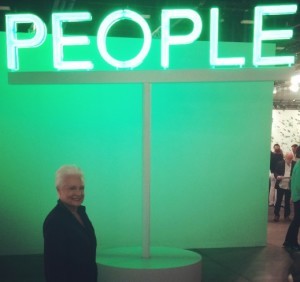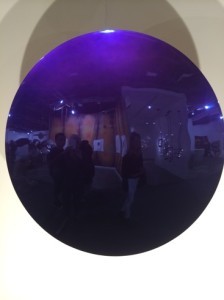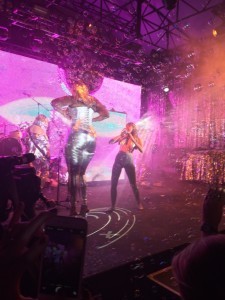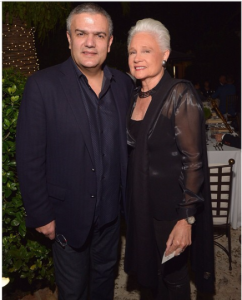The Art Newspaper
Year of record sales, but at what cost to the art?
Unease grows as it gets harder for artists to resist servicing a booming marketBy Charlotte Burns. News, Issue 264, January 2015 Published online: 22 December 2014
 Works such as Jeff Koons's Balloon Monkey have helped to propel the artist to the dual position of the world’s most expensive living artist and a cultural phenomenon over the past 18 months. © Christie's
Works such as Jeff Koons's Balloon Monkey have helped to propel the artist to the dual position of the world’s most expensive living artist and a cultural phenomenon over the past 18 months. © Christie's
The art market appeared to be in rude health as 2014 drew to a close. More money was spent on blue-chip and emerging art last year than at any other point in history, and the trade has been in rapid expansion mode. But under the surface, the tectonic plates are shifting, and unease is bubbling up about the effects of the market on the art that fuels it.
“The market has been eating the art,” says Robert Storr, the dean of the Yale University School of Art. “There are still good dealers who understand the danger, and artists who can say no. But we’re in a perilous position and we need to talk about it.”
Buyers spent a staggering $1.66bn on contemporary art in four days of auctions in New York last November, including a record-breaking total of $852.8m at Christie’s. Even so, both houses dropped their chief executives soon after the sales. Sotheby’s has yet to announce a successor to Bill Ruprecht, while Christie’s has replaced Steven Murphy with Patricia Barbizet. She is François Pinault’s long-time and trusted executive but may prove to be an interim head of his auction house.
Hawkish guarantees
Whoever ends up in charge of the auction houses faces big challenges. They need to mend strained internal relationships: the rush towards corporate growth has frustrated the specialists, many of whom feel sidelined by the companies’ aggressive diversification into new geographic and digital areas. Should the houses choose to refocus on profits over market share, we may see changes in their hawkish guarantee strategies.
In November alone, Christie’s backed contemporary art worth at least $429.8m, and Sotheby’s $184.2m, in expensive private deals with unknown margins. Meanwhile, the underdog is in the ascendant: Phillips, now under the leadership of former Christie’s chief executive Edward Dolman, has been on a stealthy recruitment drive.
Sandwiching the auctions were art fairs at which dealers reported strong sales, including Frieze in London last October and Art Basel in Miami Beach last month. Both art fairs have expanded over the past couple of years and now find themselves in transition. The founders of Frieze, Matthew Slotover and Amanda Sharp, are handing over the reins of their contemporary fairs. This comes at a point when the costs of running their New York event (14-17 May) will be higher than ever, after an agreement to use union labour.
Meanwhile, the senior management team at Art Basel halved in 2014 with the departure of Annette Schönholzer, who will not be replaced, and Magnus Renfrew, Art Basel’s former director in Asia. With its Hong Kong fair just months away (15-17 March), Art Basel had yet to announce Renfrew’s successor as we went to press.
Super-prime property
Corporate growth and culture have gripped the gallery business, too. A few dealers have been moving to some of the most expensive real-estate in the world. This is something of an anomaly, says Max Hollein, the director of the Städel Museum in Frankfurt. “The percentage of square footage of city centres in London, New York and Paris devoted to art and art dealing has suddenly risen. It’s [a trend] that might be considered unhealthy at a certain point,” he says.
The difficulty, some argue, is that the pressure for product is shaping the work. “Business art” was radical when Andy Warhol invented it, and still a novelty when artists such as Jeff Koons, Damien Hirst and Takashi Murakami crafted their works of Pop-culture-meets-commerce. Today’s artists simply cannot ignore it. This is the “age of the market-native artist”, says Gregor Muir, the director of London’s Institute of Contemporary Arts. “Artists are born, like it or not, into the market. It’s impossible to escape; it envelopes them. It’s up to them how they resist it—if they resist it,” he says.
Some market darlings have been tempted to cash in. Several have business plans to “make $5m in five years, like rock stars”, says one trade professional. Other in-demand artists have tried, in vain, to scupper their markets—such as Wade Guyton, who reprinted multiple copies of an existing work that was set to go to auction (Guyton’s inkjet Untitled, 2005, still sold for $3.5m at Christie’s in May 2014). Like punk music, new art has been co-opted.
Commodity trading
The fashion for contemporary art, and certain collectors’ desire to create a commodities market, becomes troubling when it robs artists of the time and space necessary to develop meaningful work. “The rapid over-valuation of young artists upsets the way in which new art is absorbed and interpreted,” says the art adviser Allan Schwartzman, co-founder of Art Agency, Partners. “When the market starts making stars out of artists who have never had a solo show, but whose work sells for $600,000 in an evening auction, it becomes very confusing.”
Crucially, “there is a separation between what the market is saying is interesting and what may well be interesting”, Schwartzman says. “There doesn’t seem to be a defining artist who has emerged with a vision to shift the paradigm of art and how we experience it since Matthew Barney [in the 1990s].”
These are different times, though. When Barney broke on to the scene, “talk mattered more than money—it’s not like he ever dominated the auctions and fairs”, says Felix Salmon, a finance journalist and senior editor at Fusion. “There was a difference then between whom we were talking about and where the money went. Those things have merged.”
This shift makes it hard for today’s artists to receive recognition unless they become expensive. Making money from art is no bad thing, but “it has always been the case that you do not want to be swallowed whole by your patrons”, Robert Storr says. “Once you start to operate at a distance from your centre as an artist, then you’re really in trouble.”
The dynamics have tilted in favour of the patrons. “There’s no doubt that collectors have taken control of the art world. Critics have taken a back seat,” says the art adviser Todd Levin, the director of the Levin Art Group. “There’s a breed of buyer that’s playing for history. They want to be recognised as the ones who made the discoveries.” The problem is that these tastes seem rather myopic. “Big, messy, abstract painting about individualism,” says Gabriel Pérez-Barreiro, the director and chief curator of the Colección Cisneros. “You don’t see this so much in Latin America, for example, where the market is weak. In the US, it’s hard for artists to navigate the pressures and the competition, especially when they pay so much to go to art schools,” he says.
Metaphor for our times?
As it has expanded, the contemporary art world has become more fractured. This is potentially a good thing: it means that lots of different conversations are happening at once. “It’s not that there aren’t interesting artists producing challenging work,” Felix Salmon says. “It’s that certain factions have become too solipsistic to notice them.”
Some see the display by Christie’s of works in Jeff Koons’s “Celebration” series, which dominated the auctioneer’s New York entrance in 2013 and 2014, as a big, shiny book-end to an era. These works have helped to propel Koons to the dual position of the world’s most expensive living artist and a cultural phenomenon over the past 18 months: the internet is littered with selfies taken in front of his giant sculptures. “These images are about inflatable things that are physically impossible to deflate,” Storr says. “In that sense, they’re a metaphor for the market, in which people are trying to create [an] unbreakable model—and they will become inversely symbolic in time, because nothing is forever.”
Perhaps the era is merely evolving, though, not ending: Koons has been held up as a poster boy for late-capitalist art for more than 30 years. “We think our situation is unique, but it was born in the 1980s,” says the curator Scott Rothkopf, who organised “Jeff Koons: a Retrospective” at New York’s Whitney Museum of American Art in 2014. “People thought the economic recession of 2008 would mark the end of an era for the art market, but it didn’t,” he says. “The social fabric of our country has not changed, and this age won’t end until there is much larger political and economic realignment on a global scale.”
Such upheaval could be imminent, Levin says. He points to the drastic slump in oil prices and the collapse of the Russian rouble in December, and to the contraction in Chinese manufacturing and currency volatility in the financial markets. “Should the contagion spread to the US economy, then it’s anybody’s guess as to how it will play out,” he says. “It is quite possible that the art market has reached a summit."
http://www.theartnewspaper.com/articles/Year-of-record-sales-but-at-what-cost-to-the-art/36684
 The sunny skies of Miami Beach, attracting snowbirds for a century Photo: Ap/ Fotolia
The sunny skies of Miami Beach, attracting snowbirds for a century Photo: Ap/ Fotolia












